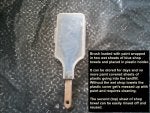Like to share this with you,
it might be helpful to some of you and save on paint covered sheets of plastic going to the landfills.
When I first started to use these plastic covers I got excited but very quickly got disappointed in them because they got covered
on the inside with paint and required spending time and water cleaning them, especially after few days paint on the edges was bit on drier side
and sticking to the plastic cover.
But I hated the idea of going back to use pieces of plastic to wrap my brushes and rollers and throwing those soaked in paint pieces of plastic in the garbage.
So here is my remedy.
It makes storing brushes and rollers less messy and friendlier to the environment.
it might be helpful to some of you and save on paint covered sheets of plastic going to the landfills.
When I first started to use these plastic covers I got excited but very quickly got disappointed in them because they got covered
on the inside with paint and required spending time and water cleaning them, especially after few days paint on the edges was bit on drier side
and sticking to the plastic cover.
But I hated the idea of going back to use pieces of plastic to wrap my brushes and rollers and throwing those soaked in paint pieces of plastic in the garbage.
So here is my remedy.
It makes storing brushes and rollers less messy and friendlier to the environment.



















